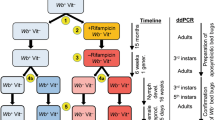Abstract
IT is well known that, during starvation, the bed-bug, like many other insects, swallows considerable quantities of air, which serve to maintain the body volume in place of the food and tissues that are consumed. I have recently observed that if the first stage larvae of the bed-bug are kept for several weeks in a moderately dry atmosphere (for example, 50 per cent relative humidity at 23° C), as the circulating fluids become less, the gut, containing bubbles of air, becomes herniated into the bases of the limbs, and may extend far down the femora (Fig. 1).
Similar content being viewed by others
Author information
Authors and Affiliations
Rights and permissions
About this article
Cite this article
WIGGLESWORTH, V. Effect of Desiccation on the Bed-bug (Cimex lectularlus). Nature 127, 307–308 (1931). https://doi.org/10.1038/127307b0
Issue Date:
DOI: https://doi.org/10.1038/127307b0
- Springer Nature Limited
This article is cited by
-
Presence of undigested haemoglobin in the small intestine and haemolymph ofTriatoma infestans (Reduvvidae) infected withBlastocrithidia triatomae (Trypanosomatidae)
Parasitology Research (1990)
-
Eine merkwürdige Blausäureschädigung bei Larven der Wanze Rhodnius pictipes Stål (Triat. hemipt.)
Zeitschrift für Parasitenkunde (1934)
-
Beiträge zur Biologie der Bettwanze (Cimex lectularius L.)
Zeitschrift für Parasitenkunde (1932)
-
Über Lebensbedingungen, Verhalten und Fruchtbarkeit der tropischen Hauswanze Cimex rotundatus Sign. (Hex. rhynch.) in Venezuela Beiträge zur experimentellen Parasitologie 7
Zeitschrift für Parasitenkunde (1931)





